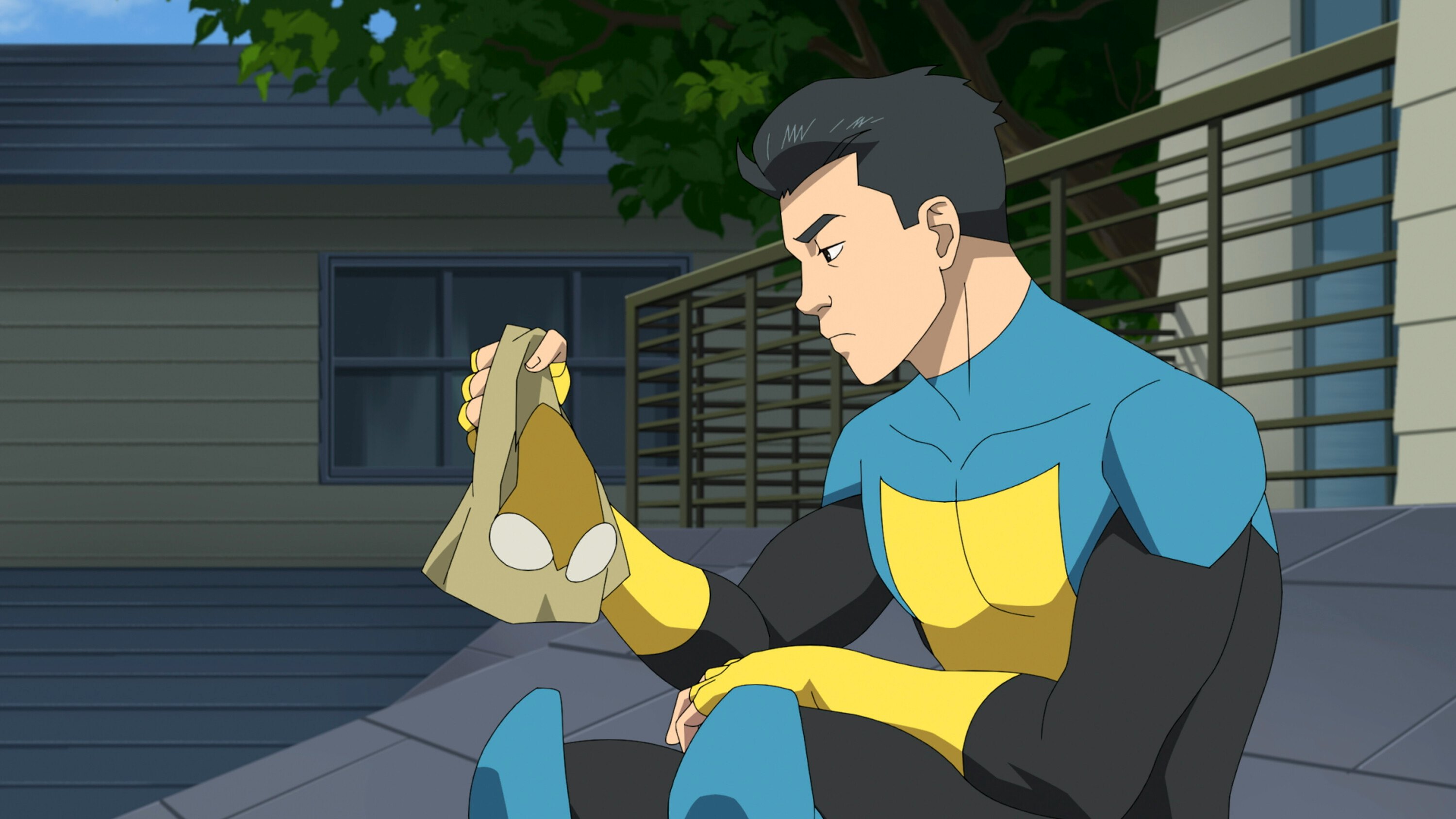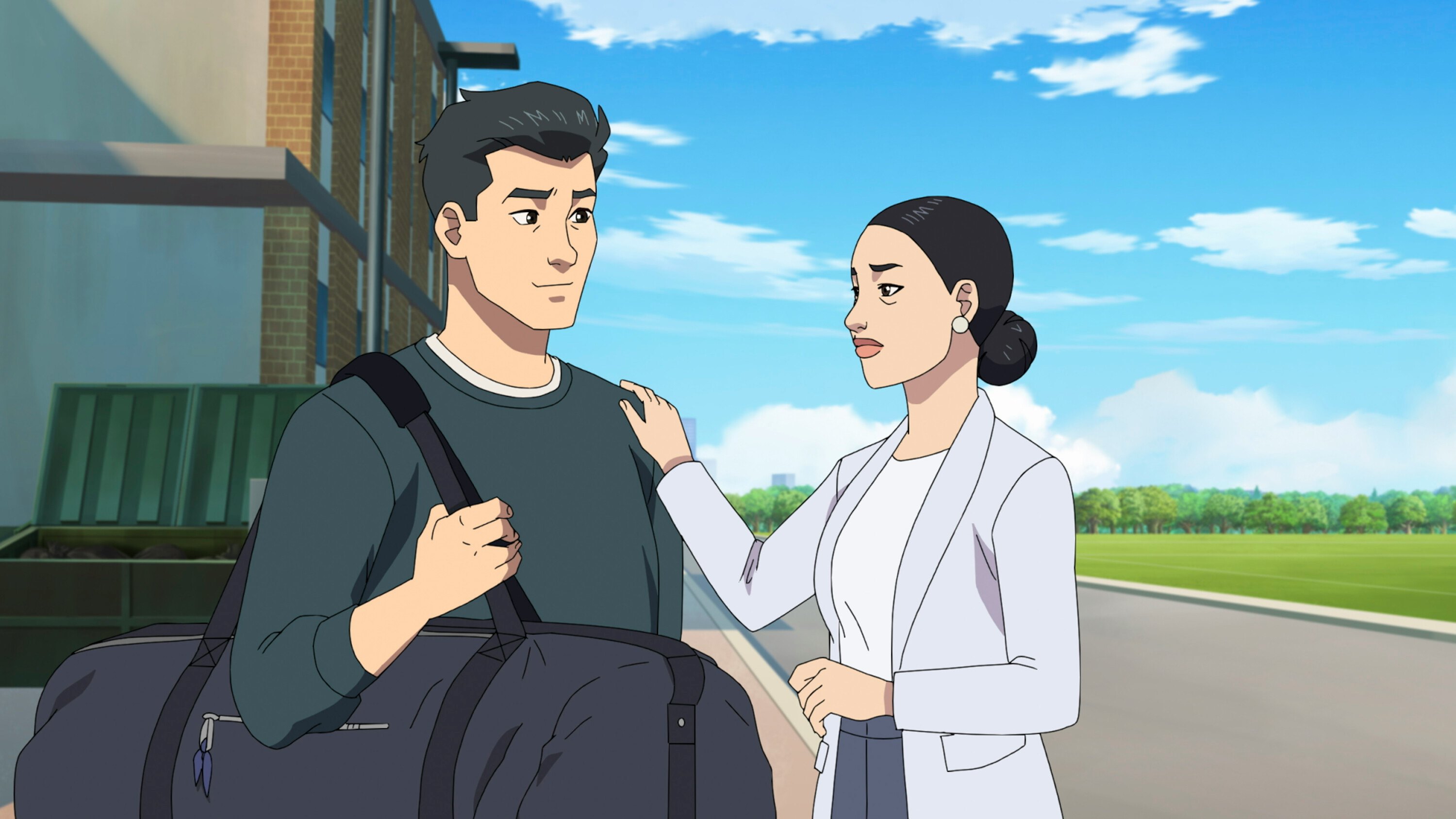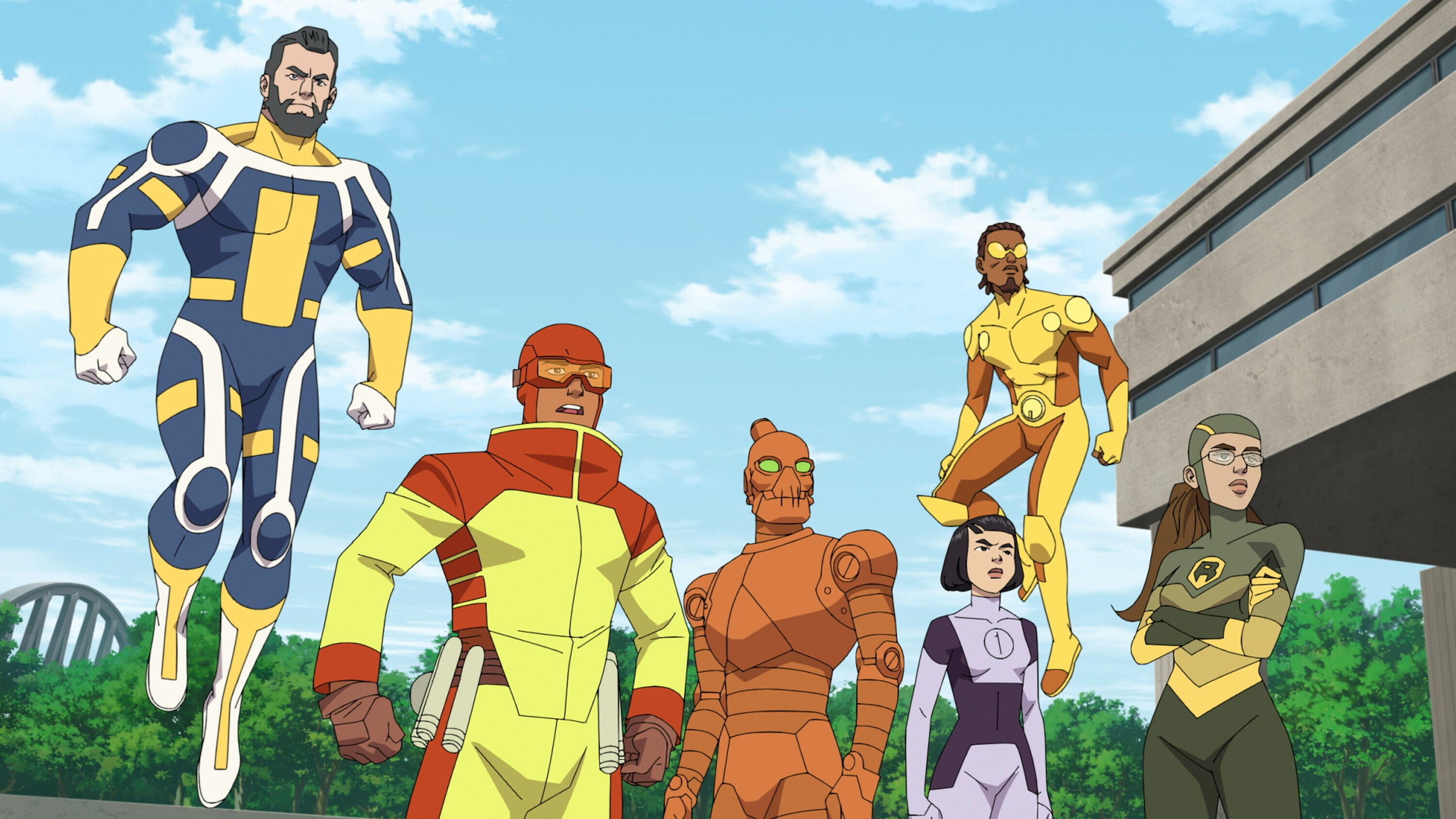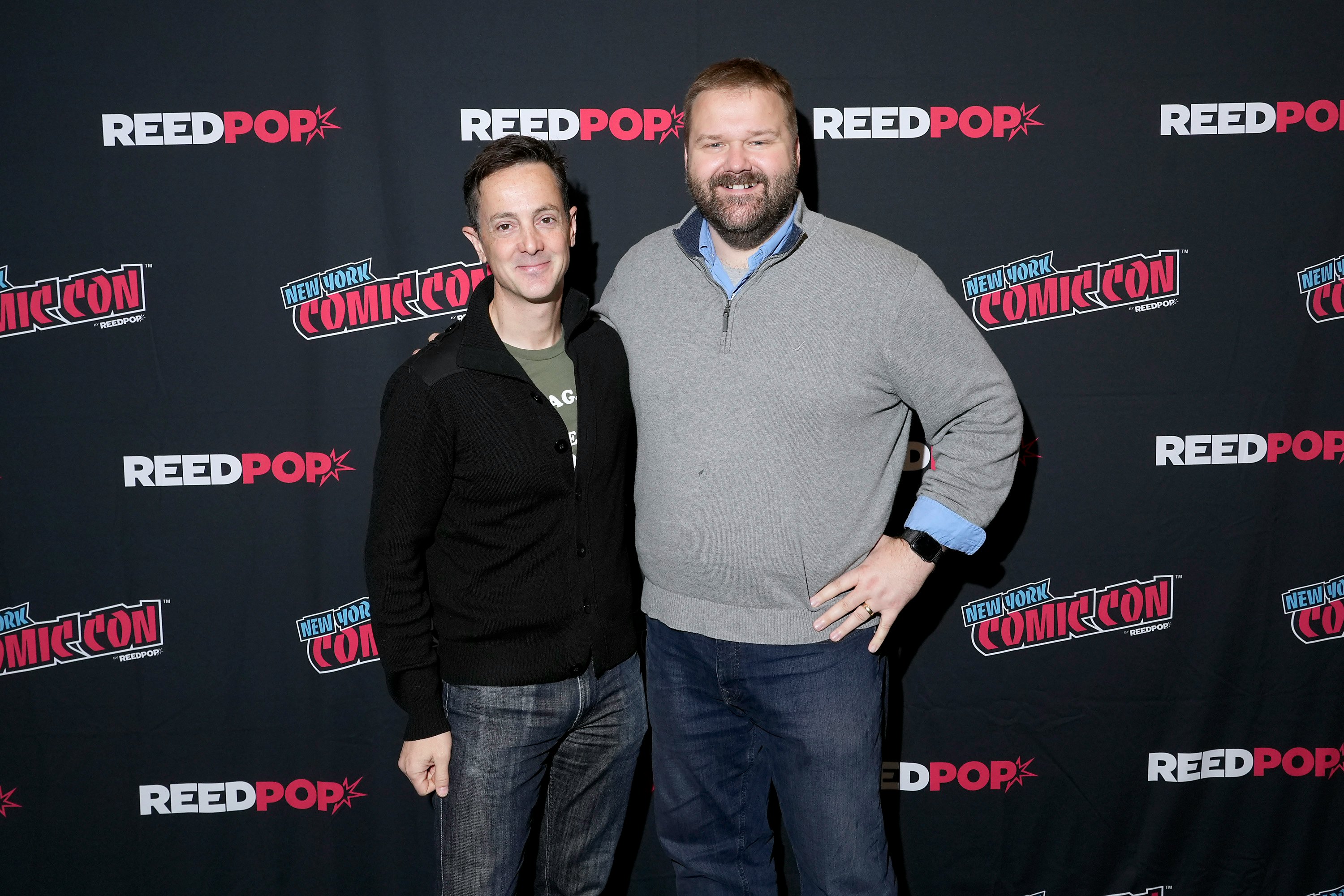
“Think, Mark, think!”
Three words, delivered with roaring fury by J.K. Simmons, perfectly encapsulate the climactic finale of Invincible Season 1, a bloody battle between father and son over the revelation that they aren’t Earth’s super-powered protectors, but its alien colonizers. But what nobody expected was that the same scene from Amazon’s animated series would go on to spark a million memes.
“Nothing makes me older than the memes,” Invincible creator Robert Kirkman tells Inverse. “It’s not like we did it on purpose. We’re certainly not sitting around going, ‘This will be a good meme.’”
Now, on the eve of the show’s long-awaited return, Kirkman can’t help but wonder if the show will find a way to go viral again. “I’m wondering if there will be no memes from Season 2 or just as many. I can’t conceive of what will be turned into memes, which again, just makes me feel super old.”
“‘Oh, God, did we screw up?’”
But the pressures on Invincible Season 2 extend far beyond how many memes it delivers. More than two years after the comic book adaptation became a breakout streaming hit, Kirkman, who co-showruns the series with executive producer Simon Racioppa, is well aware of the sky-high expectations around their show’s return.
At the very least, he simply doesn’t want to fumble the ball.
“We wanted to make sure we didn’t screw up what we had going,” Kirkman tells Inverse. “We had taken narrative risks in Season 1. There were certain things that could have landed poorly. The fact that didn’t happen put us in a position to push Season 2 more, to take more risks and do more crazy things. Now it’s like, ‘Oh, God, did we screw up?’”

When Invincible left off, teenage superhero Mark Grayson/Invincible (voiced by Steven Yeun) is beaten to within an inch of his life by his father, the powerful Omni-Man (Simmons) who revealed his true purpose as Earth’s designated invader for a powerful alien empire. Their bloody battle — illustrative of wars waged between fathers and sons as much as it is about good versus evil — left behind major devastation, including thousands of innocent lives.
Invincible Season 2 resumes in the aftermath. As Mark heals and goes to college, Omni-Man is nowhere to be found, while everyone else is picking up the pieces in their own ways. Similarly, everyone behind the scenes of Invincible strove to figure out how to get in the groove — and more importantly, how to evolve — after leaving everything on the table the first time.
“We just want to make a great show,” says showrunner Racioppa, who describes making TV as striking a “deal” with an audience. “You give us an hour of your time. That’s a lot. You could be outside, playing with your kids, watching some other show. I respect that. So in return, I want to give you the best hour of television we can make.”
A Slice of Real Life

Invincible is more than just another young adult drama in superhero spandex. An adaptation of Kirkman’s comic series published by Image, the show presents itself as a violent and subversive alternative to Marvel and DC. Invincible intentionally evokes the familiar conventions of superhero adventures, and aesthetically, it resembles a Saturday morning cartoon. But when the bones start breaking, the blood starts oozing, and the messy lives of heroes (and villains) are upended in genuinely relatable ways, Invincible makes a great case that the superhero genre remains an exciting vehicle to explore the depths of humanity.
To wit, Invincible spends its second season emotionally unpacking its main characters Mark; Mark’s mother, Debbie (voiced by Sandra Oh); and later on, Omni-Man. While Mark embarks on a path to true young adulthood as a college freshman living away from home, Debbie grapples with the trauma of having a monstrous alien murderer for an ex-husband.
“It’s a period of great change,” says Racioppa. “For Mark, [it’s about] the responsibilities of having powers. Shouldn’t he be out saving as many lives as he can? Maybe, but he has to have a life or else he would burn out. That’s also the struggle of leaving your parents’ house. There’s total freedom, but there have to be constraints on how you live life to make it sustainable.”
Racioppa adds that in Season 2, Mark is still healing from wounds, physical and emotional. “We pick up a month later, so all that stuff is completely fresh. He’s got guilt about what happened. People died because of him. That’s the baggage Mark is carrying as he grows up.”
“This is not a teen superhero story; this is about a person from their teen years to young adulthood to middle age. We’re in this for the long haul.”
Kirkman recalls penning Mark’s college-bound storyline for the comics almost 20 years ago.
“It was quick to be 17 issues in the run and go, ‘High school is boring,’” Kirkman tells Inverse. “There were storylines I could have done in high school. [I] never did a prom [issue] or anything like that. To me the most important thing was to continue the characters’ evolution. That transition from high school to college, I hope signaled to the audience, ‘You are going to be following this character for a long time.’ I’m also hoping that happens on the TV show.”
Adds Kirkman, “This is not a teen superhero story; this is about a person from their teen years to young adulthood to middle age. We’re in this for the long haul.”
Meanwhile, Debbie’s story is rooted in real-life cases of spouses who find the person they married isn’t who they thought they were. Haunted by the way Omni-Man described her to their son as a beloved “pet,” Debbie spends almost all of Season 2 reclaiming her dignity.
“Debbie’s story, about being betrayed by a partner of 20 years, that happens in real life,” says Racioppa. “You find stories of people whose partner turned out to be a murderer. What does that do to a person?”

Racioppa says the Invincible writing team researched the lives of people married to killers for inspiration, so that the characters, even the ones with powers, can “feel like real people.”
“You can find real-life stories of people whose partners turn out to be a murderer,” Racioppa says. “We look at those events and see how those affect real-life people [and] we draw elements from that into our scripts… Even in a crazy superhero show like ours, a lot of it can be very grounded and you can find these stories in the real world.”
The remaining main character of Invincible, the intimidating yet meme-worthy Omni-Man, looms large even if his presence isn’t immediately felt. Without giving away any spoilers, both Racioppa and Kirkman say Omni-Man will undergo his own challenges throughout the new season.
“What’s important about Omni-Man is that he never changes,” Kirkman says. “Every aspect of him is present. If we do our jobs right, our understanding of him will evolve.” Kirkman shuts down any notions of a redemption arc for Omni-Man. “That’s not what we’re trying to do. What we’re dealing with here is an alien being.”
Racioppa echoes Kirkman’s sentiments, plainly pointing out no one can “just apologize for murdering people.”
“There’s a long path back if you choose to take it, and I’m not saying Omni-Man does,” he says, though he teases that Omni-Man has definitely undergone some internal rewiring of his view on things. “If we revisit him, he may have different thoughts after his time on Earth. You see this at the end of Season 1; he doesn’t kill Mark. He’s having doubts. But it’s not a switch you can flip, good to bad. You don’t just get to move on, because our other characters can’t.”
Long Waits, Begone

After Invincible ended its first season, a captive audience waited with baited breath for more. And they waited. And waited. While they enjoyed a standalone special centered on breakout hero Atom Eve (Gillian Jacobs), there was still a long two years before Invincible would continue its main story in Season 2.
The long wait, Racioppa says, was critical for the show to reorganize a once-scattered pipeline that was all over the place. Different aspects of the show were handled across different studios in Los Angeles, Vancouver, and overseas in Korea and Japan.
“Our pipeline in Season 1 was not as efficient as it could be,” he says, “so we took more time to make [things] efficient.”
“I promise it won’t be that long again.”
In a change of pace from Season 1, almost all facets of production now fall under Skybound Animation — a subsidiary of Skybound Entertainment, Kirkman’s company he co-founded with David Alpert in 2010 — allowing the show to create a new procedure for Season 2 and beyond.
Racioppa says the bonus time gave them the rare opportunity to fine-tune the story and experiment on the fly. But he promises long waits will not be the norm going forward.
“[The long time] let us spend more time on the scripts,” Racioppa says, “to step back and come back and improve upon them. Infinite time isn’t always the best because you second-guess everything. But a little more time is good, to explore, to experiment, since TV is normally very rushed. That said, I wish it hadn’t been so long. I wish it were quicker. I promise it won’t be that long again. No one wants to wait that long. I don’t want to wait that long [either].”
The Future of the Invincible Multiverse

It shouldn’t be a shock to anyone that Invincible starts its second season teasing a multiverse. That concept is all the rage for superhero pop culture these days, though Racioppa and Kirkman remind everyone that Invincible did it back in its comics, and for different reasons.
“We’re not doing it because everyone is doing it,” asserts Racioppa, “We’re doing it because that’s where the story goes and where it went 17 years ago. Our approach is character-first. It’s not an excuse to bring back the Michael Keaton Invincible, because we don’t have that. We don’t have other versions other than the comic books. So for us, it’s character-based.”
“I think it’s a storytelling device used to explore character. It’s not a marketing device [for us],” Kirkman says. “We’re using it to enhance the story of Mark worrying he may become Omni-Man. Through the multiverse, he may get a glimpse. We’re doing it as a character exploration, not something to add fan service stuff.”
“If we are experiencing a period of superhero fatigue, I think that’s a great time.”
The evocation of the multiverse so early in Season 2 may call to mind general exhaustion by audiences towards similar superhero epics. But Kirkman believes that now, of all times, is the right time for Invincible.
“If we are experiencing a period of superhero fatigue, I think that’s a great time,” he says, recalling when Invincible debuted as a comic in 2003, amid Marvel and DC’s long-standing dominance in the industry. “Invincible was a comic book for people who loved superheroes but were maybe tired reading the same superheroes for so long. In that respect, it’s a perfect time for Invincible to drop a second season.”
“I don’t know if it’s superhero fatigue, but similar story fatigue maybe,” says Racioppa, who offers a deceptively simple piece of advice to others in the superhero space.
“Tell a great story,” he says. “A lot of movies and shows are starting to feel the same. But if someone comes along and reinvents it in a different way, with a cool story, that’s going to work. I know that if we focus on characters, their emotions, and the things they’re going through, we’ll be OK. That’s true for anybody. Just make a great story. The audience will enjoy it or they won’t.”

If Invincible can dominate like it did before, maybe it can tell great stories for a long time. Kirkman has a vague idea how to end the show. “It’s a moving target,” he describes, adding that to fully adapt the comic would be “seven to eight seasons.”
“Whether or not we get that is unknown,” he points out. “I also think there’s a chance the way the comic ends sets up a lot of other storylines. It’s possible the animated series lasts beyond that point, and there’s new stories. I’m happy the way Invincible [the comic] ended. I’m excited at the possibility of adapting that ending into the show. But it’s a long way away.”
Until then, there’s still the matter of getting Season 2 in front of people. But Kirkman seems to like being vulnerable instead of... you know.
“I think that’s where you want to be. You don’t want to be like, ‘We did the same thing and everything’s fine.’ It might be easier on the nerves but I feel like you’ve got to keep pushing boundaries and see what the limits are. I won’t stop until people hate the show.”







